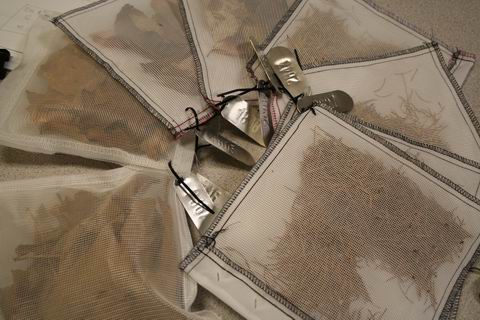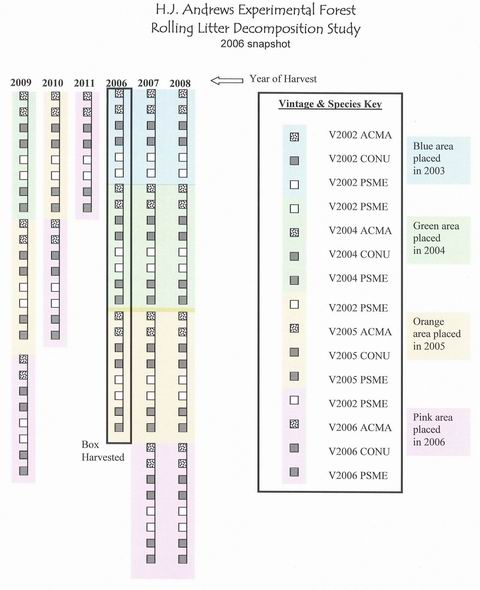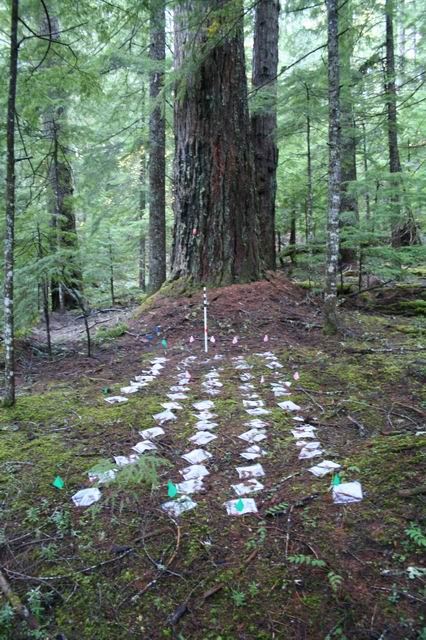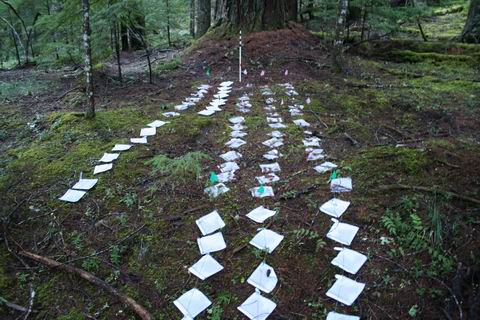Although litter decomposition has been studied for over 30 years at the Andrews, there has been no specific project to look at year to year variability of this process. Moreover, there has been no effort to quantify the degree that litter decomposition at one site is correlated to that at another site. We have therefore started the "rolling" litter decomposition study, which is designed to shed light on both temporal and spatial variation in this key ecosystem process. A range of site conditions were selected (low versus high elevation, dry versus wet, open versus closed) to contrast the extremes in site conditions at the Andrews.
 |
Established in Fall of 2003, this study examines litter decomposition of three species of native trees at 16 sites within the H.J. Andrews Experimental Forest. The species are Douglas-fir, Pacific Dogwood, and bigleaf maple and collections of these species senescent litter are gathered each year and added to the decomposition array. The sites vary in elevation, aspect, moisture regime, and forest cover.
The focus of this study is quantifying the effect of different micro-environments on the litter decay process within the same forested area. Additionally this study will compare decay rates for these species during different years and the decay rate of different litter "vintages" in the same micro-environment and decay period.
All litter bags are 20 cm X 20 cm with the lower panel made of polyester flag oxford broadcloth and the upper panel made of 1 mm mesh nylon netting. The litter bags are filled with an air-dried, weighed sample of leaves and are closed with non-ferrous MONEL staples. Sub samples are oven dried and the moisture content measured with these samples is used to calculate the oven dry equivalent of each litter bag sample. Each harvest group is strung together on braided nylon seine twine and anchored with a pin flag at each end.
Upon harvest the litter bag is placed in a zip lock plastic bag for transport from the forest to the lab. In the lab each litter bag is cut open and the litter material within is removed, weighed, and placed in a labeled paper bag. The empty paper bags have been sorted by weight into 0.05 gram weight groups to minimize error due to variation in bag weight. After oven drying at 55 degrees centigrade until a constant weight is achieved, the samples are weighed and a dry weight is recorded. Preliminary percent mass loss data is recorded without ash free correction.
This study will continue to grow as five harvest lines are set out each year and one harvest line is brought in, until 2008, when new harvest lines will no longer be added and after 4 more harvests the study will terminate.
Additionally fine mesh panels of approximately 60 cm X 60 cm will be placed out at these sites annually. These panels will be stacked over time, delineating each years litter fall from the next. At the end of this study these stacked litter layers will be harvested and analyzed in regards to both rate of decomposition and physical characteristics of the litter of different ages. This litter will be largely unconfined by artificial enclosure and should provide insight into the effect of litter bags on decomposition.
The images below illustrate the arrangement and growth over time of the Rolling Litter Study experimental array. Each year a vertical group of samples is harvested and additional groups of litterbags are installed, representing the current years litter crop. This design provides the opportunity to track the decay rate of the same litter material in different years of exposure as PSME of vintage 2002 are placed out each year. It also allows comparrison of decay progression of the same species of litter from different begining years, and the comparison of decay rates of litter from different vintage years at the same location. The last aspect of analysis, and perhaps the most important, is the comparrison between the 16 study locations within the H.J. Andrews Experimental Forest with the same litter material, during the same years, determining the coherence of decay throughout a varied landscape.
| 2004 Array | 2005 Array | 2006 Array |
|---|---|---|
 |
 |
 |
| Site 10 2004 Array | Site 10 2005 Array | |
 |
 |